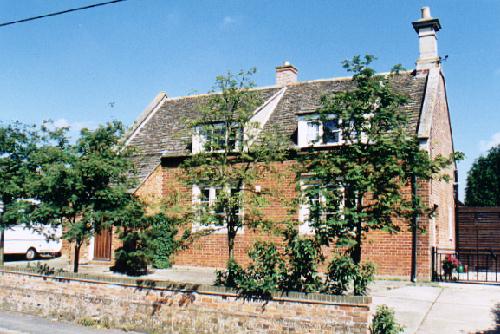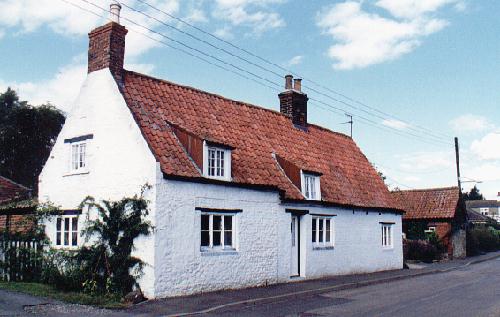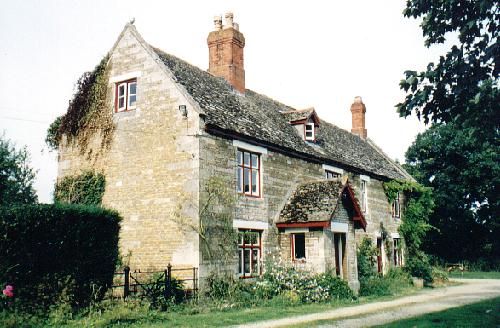|
Haconby

The spelling of the village name
as Haconby or Hacconby has engaged the attention of local historians and journalists for decades
and even now the debate continues yet the use of only one "c" was officially confirmed in
1960 on the insistence of the Ordnance Survey which was preparing new maps and
endorsed by Kesteven District Council, now superseded by Lincolnshire County
Council. Most of the signs in and around the village therefore say Haconby although one or two which are more ancient in origin stick to the old spelling of Hacconby
which also still crops up in guide books and circulars and even on some maps.
Haconby's name links it with the marauding Danes of long ago but it is now a cluster of houses on a fenland road, grouped around the old church. The village is certainly an ancient one and is mentioned in the Domesday survey of 1086. The varied spellings of that time include
Haconesbi, Hacunesbi and Haconebi and later recorded variations include the Danish Hacunebi (1135-54),
Hakunebi (1170) and Hakonebi (1199). But to ascertain its origins we have to go back another 100 years when the name meant Hákon's farmstead or village from the Old Danish
Hákon and by. The variations have continued until recent times and White's Lincolnshire for 1856 records both Hacconby and Hackenby.
This is a busy farming community looking out across the fens which stretch away eastward as far as the eye can see while the graceful spire of St Andrew's Church that soars over the clerestory battlements welcomes visitors across the meadows as they approach from the A15, three miles north of Bourne.
In Roman times, the village was prime sheep pasturage and archaeology has
revealed that up to 100,000 sheep were grazed in the parish. Records also show
that in 1307, the King kept a gerfalcon, a large bird of prey, in the village,
presumably for hunting. A map from the 18th century also shows a small plot of
land as belonging to royalty and it has been speculated that perhaps this was
the King's Falconer's territory.
By the
19th century, most of the families were engaged in farming and employed by the
area's large landowners such as the Earl of Ancaster, Thomas Lawrence, of
Haconby Hall, William Lawrence, of Dunsby, and Thomas Brown. Workers who
established a long association with Haconby were allocated one of 22 acres known
as the allotments at Haconby Top, the plots rented out from Lord Ancaster who
allowed them to grow their own food. Today, ownership of the allotments has
passed to Haconby and Stainfield Parish Council but are still used for their
original purposes although split into smaller plots.
|
There was a church here when the
Domesday Book was compiled but that has long since vanished and the present house of prayer comes chiefly from the 13th and 14th centuries. The oldest relic is a plain round Norman font and its most striking features are the nave arcades on their slender
piers. The most notable feature is the early 14th century tower, built of alternate courses of ashlar and ironstone, with a plain parapet, a tapering recessed spire, and pinnacles hugging its base.
The body of the church is a century earlier with a Perpendicular clerestory and north east chapel and, according to Henry Thorold in his Lincolnshire Churches Revisited: "A distinguished little building with a spacious interior and, although scraped, not lacking in atmosphere."
|
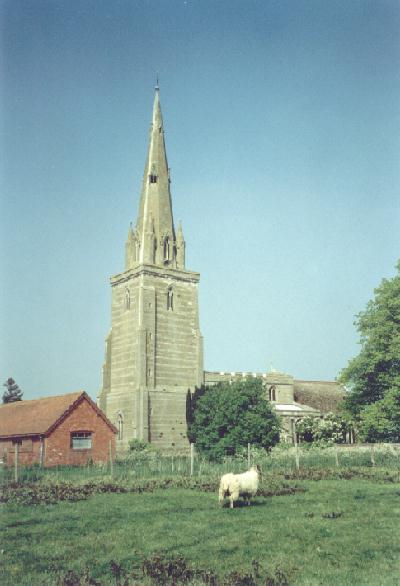 |
Today,
Haconby has few amenities of its own although at the end of the 19th century, it
boasted a tailor, a wheelwright, a grocer, draper, post office, butcher, baker
and jeweller. A 14th century chest can also be found in the church with tracery
and foliage carved on the front and posts to the left and right with dragons. It
is quoted by Dr J C Cox as a typical example of the Flemish designs of that
period. Fred Roe, writing during the last century in his History of Oak
Furniture cites "the coffer in Haconby church" as an example of scarce 14th
century work that "has been mutilated by wilful and ignorant persons". A coffer
is defined as a box "composed of single panels" whereas a chest is strictly
speaking "constructed with multiplied framing".
|
LIGHTNING STRIKES OF THE CHURCH SPIRE |
|
The spire of the village church was damaged by
lightning during a violent thunderstorm which broke out on 24th June
1845, shattering the stonework. Repairs were carried out the
following October. The height of the steeple from the ground at that
time was 133 feet and it was the upper section that was badly
damaged. Masonry was removed from the section 16 feet feet from the
top and entirely rebuilt with the addition of a new rod and copper
weather vane. The Stamford Mercury reported on Friday 24th
October: "Besides repairing the damage caused by the lightning, the
spire has been greatly improved in appearance by the restoration of
the windows with their decorative appendages which had become
mutilated and other deteriorated by time. The work was carried out
by Mr B Booth, a contractor from Boston, and considerable skill
appears to have been required in the erection of the scaffolding
etc. The parishioners have received valuable assistance towards
affecting the repair of their church in donations from several
persons including the Bishop of Lincoln, Earl Brownlow, Sir Gilbert
Heathcote, G Turner Esq., Mr Hopkinson of Stamford, the Rev T
Holdsworth. Vicar of Haconby and Morton, etc."
The spire was again struck by lightning during a thunderstorm on
22nd August 1848 when it was recorded that this was the "third or
fourth visitation of this kind within the memory of man". The
Stamford Mercury reported on Friday 1st September: "Three years
ago, from a similar cause, the cost of repairs amounted to £100. On
this last occasion, the injury was merely superficial. The situation
of the church is peculiar, there being a succession of roody
eminences to the west, with the low and level of the fens lying in
the opposite direction and extending to the sea. Frequently, in the
heat of summer, when the state of the atmosphere indicates vast
electric action, the heavy masses of clouds are seen to concentrate
on the western hills, whence they are attracted with more or less
rapidity towards the sea: while the tall and tape spire of Haconby
church appears as if intercepting the tempest in the very midst of
its career. This fact may account for the frequent recurrence of
these awful visitations in a particular locality." |
|
EARTHQUAKE DAMAGES THE CHURCH SPIRE |
|
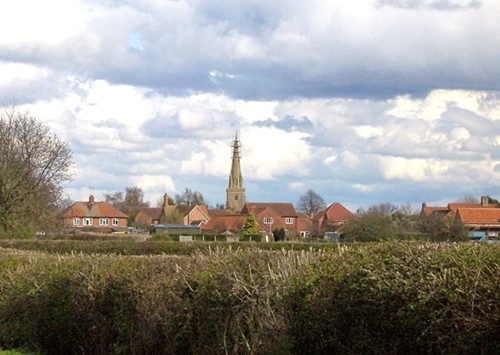 |
|
In the spring of 2008, a large crack appeared
in the slim and elegant spire of St Andrew’s church and an
earthquake which occurred in the early hours of Wednesday 27th
February that year was blamed for causing the damage. It was the
biggest tremor in Lincolnshire for a quarter of a century,
registering a magnitude of 5.3 on the Richter scale, and certainly
caused a great deal of alarm and distress in the area.
Scaffolding was erected because there was a serious risk that the
14th century steeple might collapse and so the top 18 feet of
masonry was shored up with wooded battens and the weathercock
removed until repair work could be started later in the year. The
church and graveyard were also closed to the public and the
fortnightly Sunday service was held in local houses for the time
being. An appeal to repair the damage was soon launched and
steeplejacks became a familiar sight on the spire for the next few
months but the work was completed by April 2009 when the Bishop of
Lincoln, the Rt Rev John Saxbee, made a visit to give his blessing.
Repair work involved the removal of one quarter of the stonework
from the spire which was then rebuilt with a reinforcing steel
framework while the weathercock was re-gilded.
The total cost of repairs was £73,000, most of which was covered by the insurance claim but the parochial church council also
raised £18,000 in grants from the Historic Churches Preservation
Trust, the Marshall Charity, Lincolnshire Old Churches Trust, the Kochan Trust and the Diocese of Lincoln while a further £14,000 came
from a variety of fund raising events in the village. "The
earthquake turned out to be a blessing in disguise", said Chris
Holtom, a member of the church council. "Repairs had been planned
after a steeplejack's inspection in 2007 which were sufficient and
no more but the tremors exposed the fragility of the spire thus
enabling us carry out a more substantial programme of repairs." See also
The 2008 tremor |
|
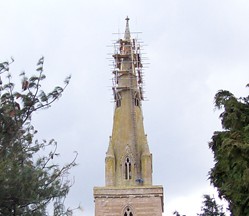 |
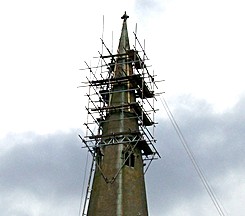 |
There
was a mill here until the 19th century when it was destroyed by fire.
The Stamford Mercury reported the incident on Friday 27th September
1867:
Hacconby
Mill and the whole of the contents were entirely destroyed by fire early
on the morning of the 19th inst., the damage being estimated at about
£400 [£20,000 in today's money] which is covered by a policy in the "Queen" Insurance
Company for which Mr Brown of Market Deeping is agent. The mill is the
joint property of Samuel Goodman of Whittlesea and William Lunn (alias
William Gregory): the former resides at Whittlesea and the latter manages
the mill and occupies a small beer-house at a short distance. It appears
that the journeyman was grinding very late on the night of Wednesday the
18th, not leaving before midnight. The fire, which commenced inside, was
discovered about half past one o'clock and is supposed to have broken out
at the neck of the mill, and to have been occasioned by the working of the
mill. It is said that the neck of the mill had previously taken fire from
the same cause and Mr Lunn, who was from home at the time of the
occurrence, told the journeyman, in whose charge the mill was left, to oil
the neck well.
The oldest dwelling in Haconby is reckoned to be Heggy's Cottage. It was built in the late 16th century and is a rare example of a mud and stud cottage, few of which survive in this part of Lincolnshire,
and now listed Grade II as being of architectural and historic interest. The name comes from the last permanent resident, Arthur Headland, who was known as Heggy. It has twice been threatened with demolition, firstly when it was condemned as being unfit for human habitation in 1970 although Heggy was allowed to remain, and again in 1993. Three years later, Heritage Lincolnshire declared that the cottage was an old and valued property that was at risk. It has since been restored through the efforts of the
then owner Mrs Mary Atkinson who lived at nearby at Haconby Hall. She obtained grant aid from English Heritage but also used a substantial amount of her own money to carry out the work in 1996.
Heggy' Cottage was built over 400 years ago to an L-shaped plan with an unusual pitched roof and raked dormer windows. It comprises three rooms and a lean-to, now converted into a bathroom, on the ground floor and three rooms at first floor level. It may have been built for use by the local priest because there is a track running alongside to the village church. Restoration work has been carried out efficiently and sympathetically. The cottage still contains many of the original features including low doors and oak beams and much of the period character has been retained.
Haconby
Hall was originally built in 1440 and reconstructed on a smaller scale in 1660
after being partially destroyed by fire. At the time of the English Civil War of
1642-49 it was owned by General Fynne, aide-de-camp to Oliver Cromwell who is
reputed to have slept in the former brewhouse in the grounds of the hall at the
time of the battle of Sempringham, five miles to the north, and the current
owner, John Atkinson, claims to be a descendant of General Fynne. Another
version of the Cromwell connection was related by villagers in past times, that
Oliver Cromwell is reputed to have slept in Heggy's cottage while trying to
escape from Charles I's royalist army during the English civil war and that when
his pursuers were within earshot, he took flight so fast that he forgot his
boots.
The village contains houses built in a mix of period styles including an example
of Victorian prosperity with a solid red brick and stone house of the late 19th
century standing behind cast iron railings, built around 1890 for his family by
a successful coal merchant and still in fine condition. A magnificent horse
chestnut tree stands on the village green, planted to commemorate Queen
Victoria’s Diamond Jubilee in 1897 and the centrepiece of revels and
celebrations for many years afterwards as well as being an attraction for local
youngsters who met underneath the canopy, swung from its lower branches and
played the traditional game of conkers when the seeds dropped in the autumn.
The old Victorian school at Haconby was closed in the summer of 1981 as a result
of cuts in government spending and pupils were transferred to the village school
at Morton, despite protests from parents about the long and unsafe distance
involved in travelling. It was known as Haconby Primary School, built during the mid-19th century to the traditional red brick design and much valued by parents for is scholastic success. It once had the highest number of passes in the 11-plus for places at Bourne Grammar School of any similar school in the area. It has now been converted for use as a private home with the addition of dormer windows and given the inevitable name of The Old School but the conversion is not a success and the stone tablet over the entrance that gave the original date of construction has either been lost or hidden by an incongruous porch.
There is another surprise at Haconby, one of the historic cottages in Chapel Street, a charming period property with whitewashed walls, a red pantile roof and two tiny dormer windows. It was originally a pair of dwellings, as can be seen by the two chimney stacks, and the present owners think that the building is at least 300 years old. In the yard at the side is a row of red brick stables built during Victorian times as part of the Ancaster estate and nearby is a fifty year old wooden chicken hut adorned with old metal advertising signs that were popular outside shops earlier this century.
They were collected by the owners and some were salvaged from the village shop in Haconby when it closed down. These old advertising signs have a particular appeal to anyone who remembers the England of the past because they were a familiar sight outside shops and garages between the wars and they remain an evocation of a less hectic world and those times when life proceeded at a far slower pace.
|
PHOTO GALLERY |
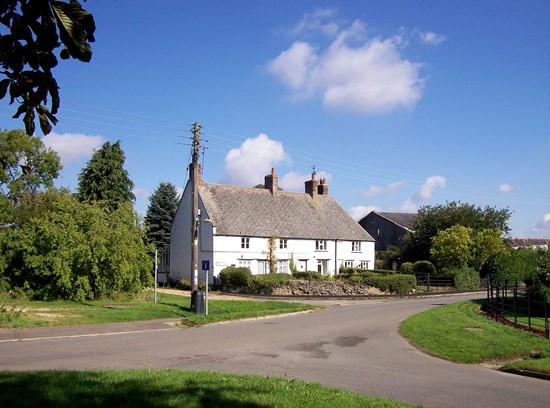 |
|
Picturesque cottages once occupied by farm workers have become a
traditional part of the rural scene in England and although many are
not as comfortable as the more modern homes, they still provide
serviceable accommodation for those who live there such as these
whitewashed properties in Chapel Street overlooking the village
green at Haconby, all still occupied and tended with loving care. |
 |
|
A charming late 19th century house at No 5 Church Street carries a
date stone for 1895 and although now hidden discreetly behind tall
trees which have grown since this picture was taken, it can still be
glimpsed through the gate. |
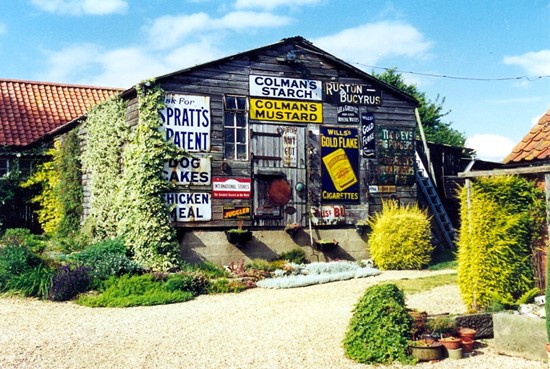 |
|
Close by one of the historic cottages at No 21
Chapel Street is an old wooden chicken hut adorned with advertising
signs collected by the owners who salvaged some from the village
shop when it closed down. These old metal enamelled signs have a
particular appeal to anyone who remembers the England of the past
because they were a familiar sight outside shops and garages between
the wars and they remain an evocation of a less hectic world and
those times when life proceeded at a far slower pace. |
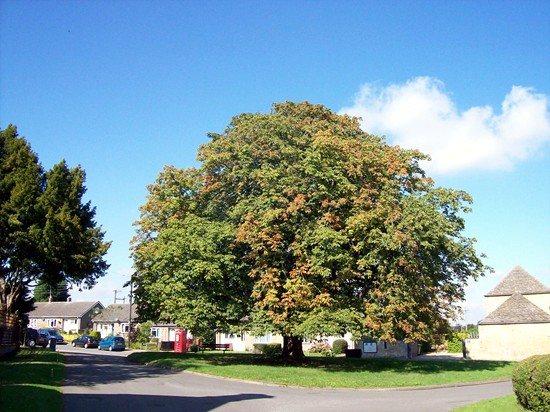 |
|
The horse chestnut tree planted on the village green in 1897 to
celebrate Queen Victoria’s Diamond Jubilee begins to shed its annual
bounty of conkers in September although they usually lie unwanted in
the grass because the traditional game played by small boys at this
time of the year is no longer popular. |
|
HACONBY IN PAST TIMES |
|
This rare photograph shows the old wooden west
gallery for singers and musicians in St Andrew’s Church shortly
before it was dismantled in 1899. During the 18th century, most
churches and chapels in England had such a gallery as music began to
be heard after the drastic restrictions of Puritan rule. The
fashion, however, did not last, and most had lost their west
galleries by the end of the 19th century. |
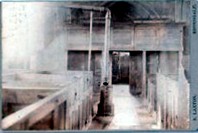 |
|
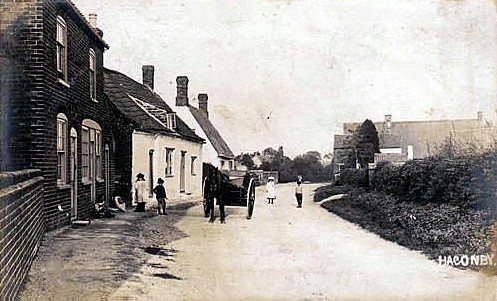 |
|
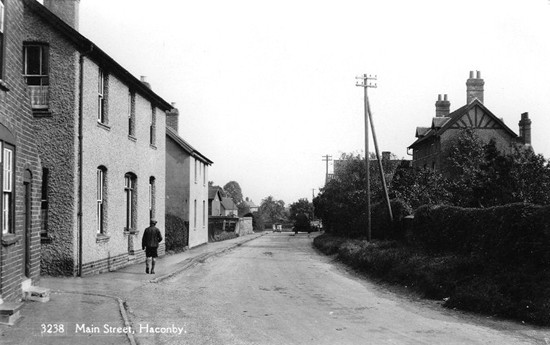 |
|
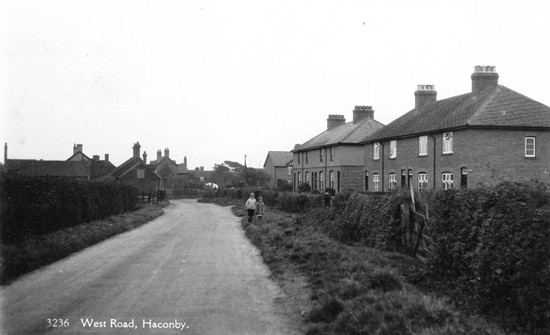 |
|
WHAT'S IN A NAME
|
|
The name Haconby, spelled with one
"c", was finally adopted in 1960. The Ordnance Survey were busy preparing new maps for the area and on discovering the variation in spelling between Haconby and Hacconby in previous publications, decided to seek the opinion of the local authorities.
South Kesteven Rural District Council met at Bourne on Thursday November 17th to discuss the issue but it was soon revealed that there was also a third spelling in use in some places: Hackonby.
During the discussion,
the clerk, Mr J Goulder, produced a letter from the Vicar of
Morton with Hacconby, the Rev E G Close, who had carried out
extensive research into the problem. |
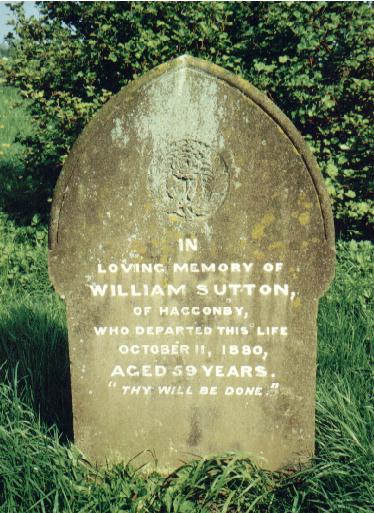 |
|
"There seems to be plenty of precedent for retaining the spelling most commonly used today, namely Hacconby", he wrote and he then went on to quote four instances from literary and other sources in which Hacconby was used:
The King's England - Lincolnshire (1949); Lincolnshire
(Cox 1916), Diocesan Calendar, and his own letters of institution as vicar under the Seal of Lincoln in 1953. He said that the Church Commissioners also used
Hacconby.
Fifteen other cases of Hacconby from documents, letters and the like were also mentioned by Mr Close against only five that favoured Haconby. The spelling was also evident in the marriage, burial and baptism registers for the parish as early as 1755 and in the Hacconby Highway Book containing payments by the Overseers of the Poor and which began in 1807 although there was a short period when Hackonby had been used. A similar variation could be noted in the parish church which had Hacconby on the chalice of 1832 and Hackonby on the paten of 1834.
A letter was also received from Mr J Goodman who signed himself as Clerk to Haconby Parish Council and which said: "My council has instructed me to write that the name of this village should be Haconby" but Mr Goodman had typed his address as "The Manor, Hacconby."
Councillor H W Wyer said that he knew of only one person in the village who spelled it Hacconby while Councillor C F Bates thought it should be Hacconby by derivation although if the parish council thought differently, he would abandon his original view.
When the issue was put to a ballot, three councillors favoured Haconby but the votes for Hacconby were so numerous that they were not counted. In the event, the final decision was taken by Kesteven County Council who chose Haconby, the spelling that is in use today, although examples of Hacconby still survive on some old road signs. |
|
FROM THE ARCHIVES
Robert Tinsley, of Haconby, aged 85, clerk, sexton, farmer, grazier,
cordwainer, publican, gardener and beeman, with an excellent character.
- from the Haconby Burials Register, 18th July 1816. Village wedding 19th century style: Robert Tomlin, aged 74, an opulent
farmer from Birthorpe, near Bourne, was married to Elizabeth Chapman of
Haconby, and who for many years was a resident at Rippingale Mill, at the
advanced age of 80 years. The ceremony was conducted at St Andrew’s
Church, Haconby, by the Rev Samuel Hopkinson. The happy couple were
attended at the church by the bride’s grandchildren and after passing the
day convivially, drove in the evening to Birthorpe to spend their
honeymoon.
– news item from the Stamford Mercury, Friday 23rd June
1820. William Richardson, aged 34, labourer of
Haconby, near Bourne, killed by a knife slipping into his thigh while
making matches and died in 10 minutes.
- from the Haconby Burials Register, 28th March 1829.
On Tuesday last, about half past three o'clock in the afternoon, an
awful thunderstorm passed over the village of Haconby, near Bourne. The
electric fluid struck the spire of the church and passed downwards through
an ancient chapel on the north side of the chancel, now used as a
schoolroom and at the time filled with children who providentially escaped
unhurt. The damage done is considerable.
- news report from the Stamford Mercury, Friday 27th June 1845.
An inquest was held on the 26th inst. by Mr W Edwards, coroner, in the
parish of Haconby, near Bourne, on the body of William Grummitt, aged 13
years, one of the sons of Mr Edward Grummitt, farmer, of that parish. The
youth was engaged in driving a manure cart from which he fell and the
wheel passing over his body. He survived the accident only a few minutes.
Assistance was immediately rendered; but he was only able to state the
cause of his death and never spoke again. Verdict, accidental death. -
news report from the Stamford Mercury, Friday 1st August 1851.
HACONBY MILL, NEAR BOURNE
To be sold by auction by Mr W E Lawrence on Thursday the 28th of August
1851.
ALL the household furniture, horse, cow, carts and other effects, the
property of Mr Charles Wellsman, at Haconby Mill aforesaid; particulars of
which may be seen in handbills. Sale to commence at two o'clock. -
public notice from the Stamford Mercury, Friday 22nd August 1851.
A LINCOLNSHIRE GENTLEMAN'S RECORD: Mr Thomas Lawrance, of Haconby Hall,
Bourne, who has just celebrated his 95th birthday, is believed to be the
oldest Land and Income Tax Commissioner living. He was one of the best
known farmers in Lincolnshire until he retired, and in former days was a
hard rider to hounds. For 50 years he was a member of the Bourne Board of
Guardians, and for the greater part of this period was chairman. He is a
cousin of Mr Justice Lawrance.
- news item from the Stamford Mercury, Friday 1st January 1904. |
See also
The Baptist Chapel at Haconby
A history of Haconby church
Robert Tinsley Sutton

Go to:
Main Index Villages
Index
|






